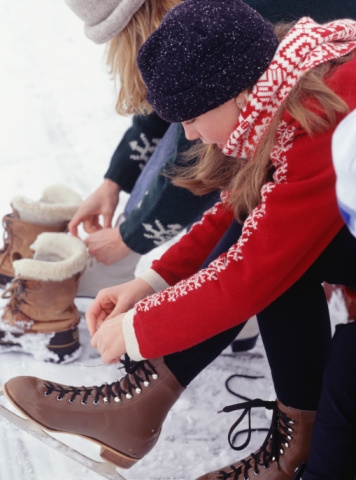With frigid temperatures and fresh snow blanketing the ground, winter has officially arrived, and with it come some thrilling seasonal sports. While careening over the snow and ice can be exhilarating, the cold temperatures, slippery surfaces and high speeds can  contribute to a host of injuries, so let's take a few minutes to discuss some winter safety tips that will help your child soak up all the snowy fun safely.
contribute to a host of injuries, so let's take a few minutes to discuss some winter safety tips that will help your child soak up all the snowy fun safely.
Suiting Up for the Weather
Before heading out, make sure to set your child up for a successful experience. Nothing dampens winter fun like shivering, so remember to dress your child warmly and in layers. Wool or synthetic wicking materials provide a great base layer that is water-resistant and breathable. Little fingers and toes are susceptible to cold-related injuries; keep them warm and dry with insulated, water-resistant gloves and boots to help prevent frostbite.
Proper protective gear including helmets, wrist guards and kneepads helps to cushion falls and reduce injuries. Even though beach season is over, don't forget to protect the skin and eyes with sunscreen and UV-resistant eyewear.
Once the crew has been properly outfitted, it's almost time to have fun.
Checking Winter Sports Gear
Prior to use, check to make sure all equipment fits and functions properly. Skates and ski/snowboard boots that are too big can be uncomfortable and difficult to control, while oversized helmets can obscure vision or fail to protect the head adequately. Ski bindings should always be checked and set for the appropriate weight and skill level of the skier. Sharpening edges before the season makes snow and ice sports both safer and easier. Sleds should be sturdy and, ideally, steerable.
Make Sure the Hill or Ice is Safe
For activities such as sledding or skating, a responsible adult should always evaluate the setting and continue to supervise the action. You should only skate on approved ice. Designated sledding areas are preferred as well, but if one isn't available, make sure there are no obstacles, no excessive crowds, adequate snow cover and conditions appropriate for the age of your sledder. Make sure there is a spacious run-out at the base of the hill, and never sled on or near roads.
Find Good Lighting
The short days of winter can mean continuing the fun into the evening, so ensure that there is adequate lighting, and be aware of the falling temperatures after dark.
Use the Right Technique
Becoming an expert in snow sports can take years, but starting with proper technique is essential to maximizing enjoyment and minimizing injuries. When in doubt, take a lesson from an experienced instructor. Falling down is a near certainty in winter sports, so learning how to fall - and get back up - safely is a valuable skill. When sledding, always travel facing forward with the feet first, never head-first.
Go Inside to Warm Up
Lastly, encourage regular breaks to dry off and warm up inside. A cup of hot cocoa is a time-honored tradition and can be a tasty enticement to come in from the cold and relax after all the winter activity.
To get everyone back to the fireside healthy and happy, remember these tips and always play smart.
Dr. Craig Finalyson has more than 10 years of experience in orthopedics and sports medicine at Ann and Robert H. Lurie Children's Hospital of Chicago. His special interests include arthroscopic surgery, sports medicine, and ACL injury in the young athlete. Dr. Finalyson has been published in the Journal of Pediatric Orthopedics and Clinical Orthopaedics and Related Research and contributed to four books. A former children's ski instructor from Colorado, he enjoys skiing, sledding and snowshoeing with his young son.









